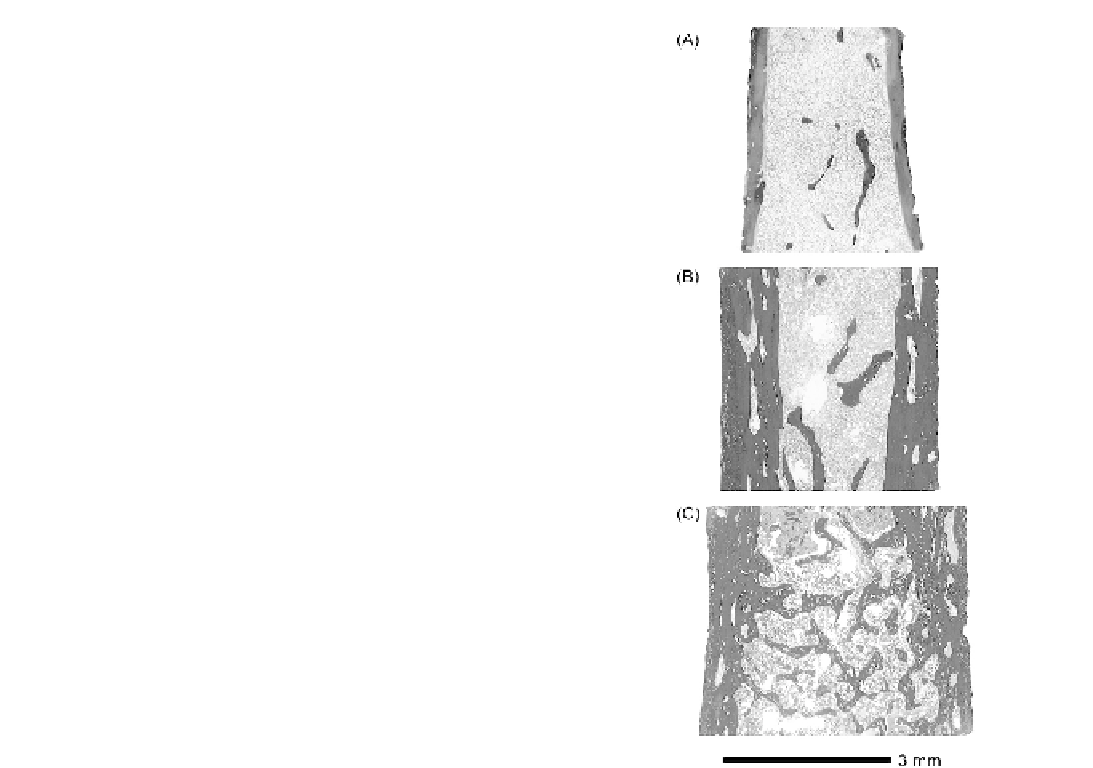what-when-how
In Depth Tutorials and Information
Other OI Types
Information on the bone histological features of
other OI types is limited to individual case reports. In
a 13-year-old boy with a homozygous mutation in the
FKBP10
gene, a relatively high amount of osteoid and
blurred tetracycline labels were detected, suggestive
of a mineralization defect.
33
However, the sample was
taken after treatment with an intravenous bisphospho-
nate, which may have influenced the results. In two
patients with collagen type I C-propeptide cleavage site
mutations an increased amount of osteoid was found in
association with increased bone matrix production.
34
EFFECTS OF BISPHOSPHONATE
TREATMENT IN OI
In children with OI, the effect of bisphosphonates on
bone tissue has been studied in some detail. In a study
on 45 children and adolescents with OI type I, III and
IV (age 1.4 years to 17.5 years), iliac bone biopsies were
obtained at the start of intravenous pamidronate treat-
ment as well as after 2 to 4 years (mean 2.4 years) of
therapy (
Figure 25.2
).
35
The main bone mass relevant
change during the treatment period was an increase
in cortical thickness of 88%. The amount of trabecular
bone increased by an average of 46%, because trabecu-
lae were more numerous. Indicators of cancellous bone
remodeling decreased by 26-75%. There was no evi-
dence for a mineralization defect in any of the patients.
These results suggested that, in growing children with
OI, pamidronate had a two-fold effect. With regard to
remodeling, bone resorption and formation are cou-
pled and consequently both processes were inhibited.
However, during modeling of cortical bone, osteoclasts
and osteoblasts are active on different surfaces and are
thus uncoupled. Therefore resorption was selectively
targeted by pamidronate, and continuing bone forma-
tion could increase cortical width.
Similar results were found in a study on 24 young
children with OI who had all received pamidronate
treatment since the first or second year of life.
36
Their
histomorphometric results after 3 years of pamidronate
treatment were compared to those of a historical con-
trol group of untreated children with severe OI who
were matched for OI type and age. Iliac bone histomor-
phometry showed 61% higher cortical width and 89%
higher cancellous bone volume in pamidronate-treated
patients. Bone formation rate per bone surface in the
pamidronate group was only 17% that of untreated
patients. Thus, pamidronate treatment started in
infancy leads to a marked increase in the amounts of
both cortical and trabecular bone, but also suppressed
bone turnover markedly.
FIGURE 25.2
Series of iliac bone samples in a boy with OI type I.
(A) Sample obtained at the age of 2.2 years, before pamidronate treat-
ment was started. (B) After 2.8 years of pamidronate treatment. (C) After
5.8 years of pamidronate treatment.
(From: Rauch F, Travers R, Glorieux
FH. Pamidronate in children with osteogenesis imperfecta: histomorphometric
effects of long-term therapy. J Clin Endocrinol Metab 2006;
91
: 511-16.)
The bone tissue effects of pamidronate in the newer
types of OI were largely similar to those found in “clas-
sical” OI types. In seven children with OI type V,
2 years of pamidronate treatment were associated
with an average increase of 86% in cortical thickness.
37
Cortical thickness also increased (+53%) after 3 years of
intravenous pamidronate in children and adolescents
with OI type VI.
38
However, the mineralization defect
which is the characteristic feature of OI type VI did not
change during pamidronate treatment. In OI type VII,
cortical width increased with pamidronate treatment, but
trabecular bone volume did not change significantly.39
39
The longer-term effects of pamidronate treatment on
the bone tissue were evaluated in a longitudinal study
of 25 children and adolescents with OI who had received
intravenous pamidronate for >4 years.
40
Iliac bone biop-
sies were performed at treatment start, after 2.7 ± 0.5
years (mean ± SD) and after 5.5 ± 0.7 years of ther-
apy. Mean cortical width and cancellous bone volume

